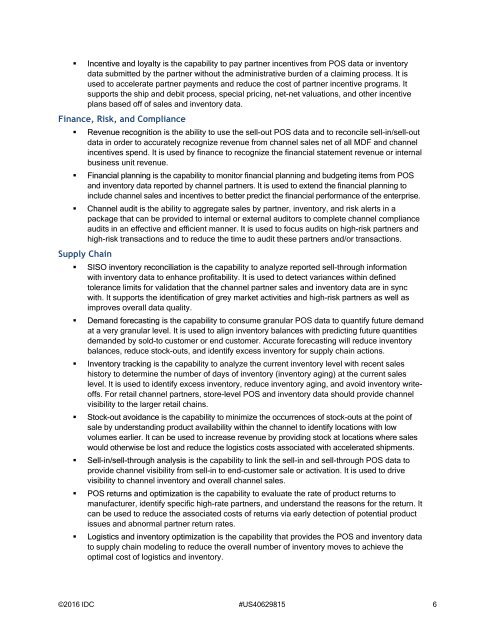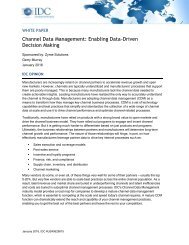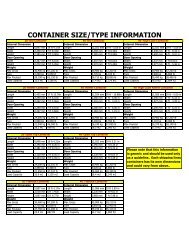White Paper Channel Data Management: Enabling Data-Driven Decision Making
This white paper presents a method for establishing channel data management as a core competency across all channel-facing departments. It includes a maturity model for driving excellence in strategy, people, process, technology, and data workstreams. Companies that embrace a new approach to channel management based on data-driven decision making will develop stronger relationships with stronger channel partners than their rivals. Companies using this model are gaining channel capacity in a time of extraordinary transformation. For more information visit our website: http://www.zyme.com/resources/white-papers/channel-data-management-enabling-data-driven-decision-making
This white paper presents a method for establishing channel data management as a core competency across all channel-facing departments. It includes a maturity model for driving excellence in strategy, people, process, technology, and data workstreams. Companies that embrace a new approach to channel management based on data-driven decision making will develop stronger relationships with stronger channel partners than their rivals. Companies using this model are gaining channel capacity in a time of extraordinary transformation. For more information visit our website: http://www.zyme.com/resources/white-papers/channel-data-management-enabling-data-driven-decision-making
You also want an ePaper? Increase the reach of your titles
YUMPU automatically turns print PDFs into web optimized ePapers that Google loves.
Incentive and loyalty is the capability to pay partner incentives from POS data or inventory<br />
data submitted by the partner without the administrative burden of a claiming process. It is<br />
used to accelerate partner payments and reduce the cost of partner incentive programs. It<br />
supports the ship and debit process, special pricing, net-net valuations, and other incentive<br />
plans based off of sales and inventory data.<br />
Finance, Risk, and Compliance<br />
<br />
<br />
<br />
Supply Chain<br />
<br />
<br />
<br />
<br />
<br />
<br />
<br />
Revenue recognition is the ability to use the sell-out POS data and to reconcile sell-in/sell-out<br />
data in order to accurately recognize revenue from channel sales net of all MDF and channel<br />
incentives spend. It is used by finance to recognize the financial statement revenue or internal<br />
business unit revenue.<br />
Financial planning is the capability to monitor financial planning and budgeting items from POS<br />
and inventory data reported by channel partners. It is used to extend the financial planning to<br />
include channel sales and incentives to better predict the financial performance of the enterprise.<br />
<strong>Channel</strong> audit is the ability to aggregate sales by partner, inventory, and risk alerts in a<br />
package that can be provided to internal or external auditors to complete channel compliance<br />
audits in an effective and efficient manner. It is used to focus audits on high-risk partners and<br />
high-risk transactions and to reduce the time to audit these partners and/or transactions.<br />
SISO inventory reconciliation is the capability to analyze reported sell-through information<br />
with inventory data to enhance profitability. It is used to detect variances within defined<br />
tolerance limits for validation that the channel partner sales and inventory data are in sync<br />
with. It supports the identification of grey market activities and high-risk partners as well as<br />
improves overall data quality.<br />
Demand forecasting is the capability to consume granular POS data to quantify future demand<br />
at a very granular level. It is used to align inventory balances with predicting future quantities<br />
demanded by sold-to customer or end customer. Accurate forecasting will reduce inventory<br />
balances, reduce stock-outs, and identify excess inventory for supply chain actions.<br />
Inventory tracking is the capability to analyze the current inventory level with recent sales<br />
history to determine the number of days of inventory (inventory aging) at the current sales<br />
level. It is used to identify excess inventory, reduce inventory aging, and avoid inventory writeoffs.<br />
For retail channel partners, store-level POS and inventory data should provide channel<br />
visibility to the larger retail chains.<br />
Stock-out avoidance is the capability to minimize the occurrences of stock-outs at the point of<br />
sale by understanding product availability within the channel to identify locations with low<br />
volumes earlier. It can be used to increase revenue by providing stock at locations where sales<br />
would otherwise be lost and reduce the logistics costs associated with accelerated shipments.<br />
Sell-in/sell-through analysis is the capability to link the sell-in and sell-through POS data to<br />
provide channel visibility from sell-in to end-customer sale or activation. It is used to drive<br />
visibility to channel inventory and overall channel sales.<br />
POS returns and optimization is the capability to evaluate the rate of product returns to<br />
manufacturer, identify specific high-rate partners, and understand the reasons for the return. It<br />
can be used to reduce the associated costs of returns via early detection of potential product<br />
issues and abnormal partner return rates.<br />
Logistics and inventory optimization is the capability that provides the POS and inventory data<br />
to supply chain modeling to reduce the overall number of inventory moves to achieve the<br />
optimal cost of logistics and inventory.<br />
©2016 IDC #US40629815 6





